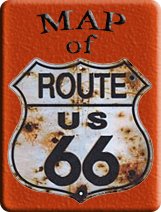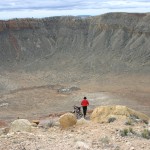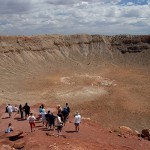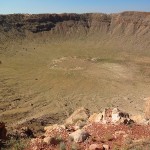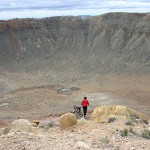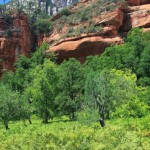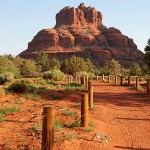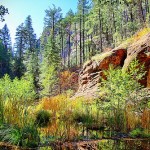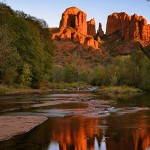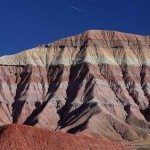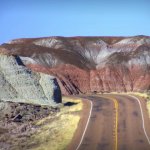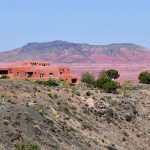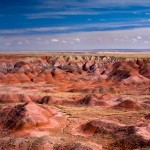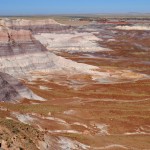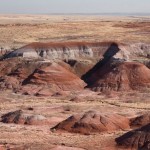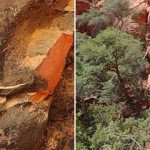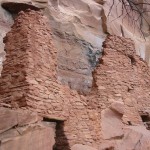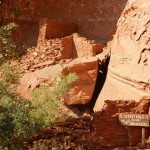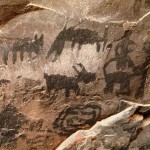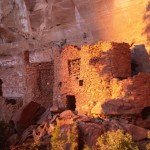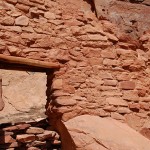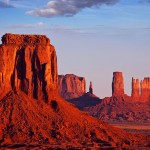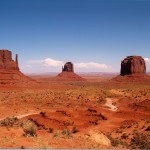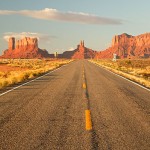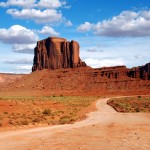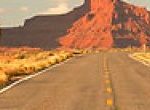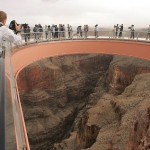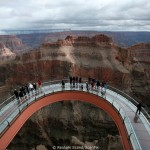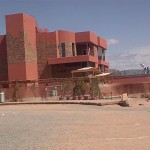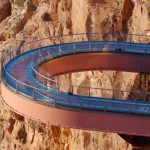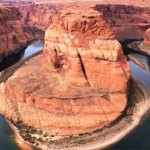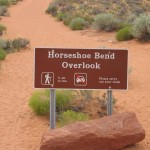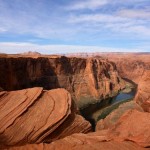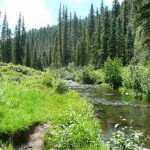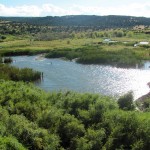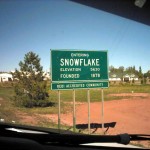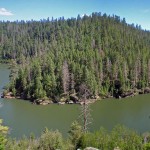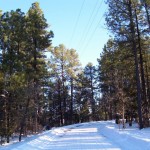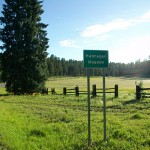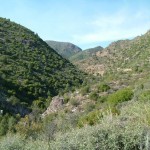ARIZONA - ATTRACTIONS
Travel Guide
Follow Us on Facebook
States
Illinois
Missouri
Kansas
Oklahoma
Texas
New Mexico
Arizona
California
Route 66 by State
Meteor Crater
One of the best preserved meteorite impact craters on earth, located in desert surroundings near interstate 40 between Flagstaff and Winslow.
Flat, sandy, arid grasslands characterise the countryside east of Flagstaff, between the wooded hills of the Mogollon Rim and the delicate hues of the Painted Desert, and the only major natural attraction is the Meteor Crater, which lies 6 miles south of I-40, half way between Winslow and Winona. This huge depression, 0.74 miles in diameter and 550 feet deep was created 49,000 years ago by meteoric impact, and its proximity to the interstate now attracts many visitors despite the high cost of entry – the crater has been privately owned by the same family since early investigations began in 1902 by Daniel M. Barringer, and is now a thriving commercial enterprise complete with such modern requirements as a movie theater, restaurant and gift shop.
See pictures below:
Sedona’s Oak Creek Canyon
Oak Creek Canyon is a river gorge located along the Mogollon Rim in northern Arizona located between the cities of Flagstaff and Sedona.
It has been recognized as one of the Top 5 Most Scenic Drives in America by Rand McNally. Oak Creek Canyon is a breathtaking stretch of beauty on a winding road that climbs 4,500 feet from Sedona to the top of the Mogollon Rim.
See pictures below:
Painted Desert
The Painted Desert is a United States desert of badlands in the Four Corners area from the Grand Canyon National Park into the Petrified Forest National Park.
The Painted Desert encompasses over 93,500 acres and stretches over 160 miles. It begins about 30 miles north of Cameron, Arizona near the southeastern rim of the Grand Canyon to the Petrified Forest about 26 miles east of Holbrook, AZ. Along the way, it grazes the backyard of the Wupatki National Monument Indian Ruins. The Painted Desert derives its name for the multitude of colors ranging from lavenders to shades of gray with vibrant colors of red, orange and pink. It is a long expanse of badland hills and buttes and although barren and austere, it is a beautiful landscape of a rainbow of colors.
See pictures below:
Ancient Ruins of Palatki
Near Sedona Arizona
A designated World Heritage Site, the Palatki Ruins are a window into the culture of ancient Arizonans. The Palatki site is filled with cliff dwellings as well as pictographs and petroglyphs that were created by the Southern Sinagua people. Although the journey there can be rough-going over some difficult terrain, the site is considered a must-see stop for anyone visiting the Sedona area.
See pictures below:
Monument Valley
You may not have ever heard of Monument Valley, but you are likely to recognize it when you see it. Monument Valley has been the setting for more western movies than any other place. No other attraction is quite like the wide open natural beauty of Monument Valley with its widely-spaced red rock monoliths spread over almost 92,000 acres.
As you tour Monument Valley, you may notice that many of the inhabitants still use horses as their main form of transportation. Many families still herd sheep, cook outside, create authentic handmade crafts and jewelry. They are very happy people but live in poverty. Never take their photos without asking their permission and giving them a monetary tip. They will appreciate that.
See pictures below:
Grand Canyon Skywalk
The Grand Canyon Skywalk is a transparent horseshoe-shaped cantilever bridge and tourist attraction in Arizona near the Colorado River on the edge of a side canyon in the Grand Canyon West area of the main canyon.
Skywalk is engineered to carry a weight of 71 million pounds. That would be sturdy enough to to hold the weight of 12 fully-loaded 747 commercial jets. It can sustain winds of over 100 miles per hour from eight different directions.
It is designed to withstand an 8.0 magnitude earthquake within 50 miles of the epicenter.
See pictures below:
Horseshoe Bend at Page Arizona
Horseshoe Bend, one of the most photographed areas on the Colorado River, located just north of Grand Canyon and outside Page Arizona. It is so named by the shape of the meandering Colorado River below as it flows one way and then makes a quick “horseshoe” turn as it continues on its path through Lees Ferry and its journey through the Grand Canyon.
See pictures below:
Arizona White Mountains
The White Mountains is a four-season wonderland. Intoxicating beauty in all seasons. A beauty that feeds the adrenalin of the adventurous who thirst for the fresh aroma of the great outdoors. Emerging wildflowers come springtime. Cool summers that entice bikers, hikers and golfers. Golden colors of autumn that crescendo into cold winters covered with snow.
Most Popluar:
- Show Low Arizona. The tourism capital of the White Mountains. Created in 1870.
- Pinetop-Lakeside. The twin communities of Pinetop and Lakeside were respectively founded in the 1880s and 1890s.
- Greer Arizona. Greer is alpine beauty. An incredible haven of year-round activity and outdoor adventure.
- Springerville Arizona. Springerville AZ lies toward the eastern end of the White Mountains in an area known as Round Valley.
- Alpine Arizona. Located just south of Springerville, Alpine matches its name with a “Swiss-like” setting.
- Snowflake/Taylor. The two towns are so close to each other, most consider them the same community.
- Hannagan Meadow. Hannagan Meadow is approximately 22 miles south of Alpine, located on the historic Coronado Trail.
- Payson Arizona. Payson AZ actually is not in the White Mountains but is a popular getaway destination about midway between the Phoenix area and the White Mountains.
See pictures below:
